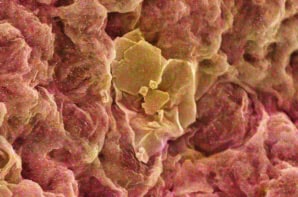
Hair cools the head in hot weather, while keeping the scalp warm in the cold – according to a new study of how human hair interacts with infrared radiation. The research was done by scientists in South Korea, who hope their work will inspire the development of new textiles with optimized radiative properties.
Despite accounting for only 2% of a typical human’s mass, the head consumes about 20% of the energy burned by the body’s metabolism. The head’s skin temperature can be over 2°C warmer than elsewhere in the body, so good thermal management is therefore crucial – particularly when the Sun is beating down onto the scalp.
Hair is an evolutionary adaptation to protect the head from both damaging solar radiation and cold. At first sight it might seem that the price of this protection is a limit on the body’s ability to keep the head cool on hot days by radiating heat from the scalp.
Radiative properties
Now, however, the materials scientist Gunwoo Kim and colleagues at the Korea Institute of Industrial Technology in Yeongcheon have challenged this view by investigating the radiative properties of hair. As well as gaining insights into hair’s infrared properties, the team has also studied how they affect the heating and cooling of the scalp a various ambient temperatures.
Hair comprises three radial layers of which the middle layer (the cortex) is by far the thickest. The cortex consists of intertwined bundles mainly made of the protein keratin and air pockets that gives hair its mechanical properties such as its strength. The outer layer is called the cuticle, which comprises multiple layers of thin, flat cells overlapping like roof tiles.
The principal absorber of solar radiation in hair (and skin) is the pigment melanin. This is polymer of an organic amino acid with rings that absorb a broad spectrum of radiation between the near-infrared and the ultraviolet.
Hair models
Kim’s group investigated how the physical and chemical properties of hair combine to affect its absorptivity (which is the same thing is its emissivity according to Kirchoff’s law of thermal radiation), reflectivity, and transmission at different wavelengths. This was done using mathematical models and by doing experiments on black hair (which is rich in melanin) obtained from a local salon.
They found that the hair samples absorbed around 80% of incident light at the infrared wavelength of 1 μm, which is the maximum intensity wavelength in solar radiance. The team also studied hair samples in which the melanin had been removed by bleaching. In these samples, the absorbance was around 40%. The team repeated its measurements for infrared light at 10 μm, which is not a significant component of sunlight. After bleaching melanin they found that the absorptivity (and emissivity) at this wavelength remained around 90%. This is because the absorbance of radiation at this wavelength is largely due to chemical bonds in molecules other than melanin – molecules such as keratin.
Next, the researchers soaked the hairs in water. They found that the proportion of solar-wavelength radiation absorbed dropped significantly, whereas the proportion of radiation absorbed at 10 μm was relatively unaffected.
Scattering pores
“Human hair has pores that are almost 1 μm,” says Kim, “Those pores are very specific for scattering in the near-infrared region…To completely block solar radiation we need a large length of hair: but if we scatter the radiation inside the material we can completely block the radiation without needing such a volume of material.”
Filling the pores and edges with water had prevented the abrupt changes in refractive index and thereby reduced the scattering necessary to increase the path length of near-infrared radiation in the hair. At longer wavelengths likely to be emitted by the human body as heat, however, the waves were not scattered but absorbed and re-emitted. The team chose to study 10 μm radiation because it is in the centre of an atmospheric “transparency window”. “We call this phenomenon radiative cooling because we can emit this radiation easily to space,” says Kim.

Polar bear fur inspires solar-thermal textiles
The researchers then conducted field trials. They found that, on a cold day, a sample of synthetic skin covered with hair ended up being warmer than the bare skin. On a warm day, however, hair-covered synthetic skin remained cooler. The researchers are now looking to develop bio-inspired textiles based on the principles outlined in a paper describing the research in Proceedings of the National Academy of Sciences.
Luis Ruiz Pestana is an expert in the modelling of nanostructured materials at the University of Miami in the US. He told Physics World that these results are both impressive and puzzling.
“The really unique thing is not that you absorb UV light, but that hair seems to be really good at emitting in the infrared,” he says; “So basically you get that UV light, you absorb it, and you release it in the infrared spectrum.”
However, he is perplexed by the cold temperature behaviour, for which the researchers provide data but little explanation: “I didn’t understand at all [how] the architecture of hair allows the infrared to remain trapped between the skin and the atmosphere,” he says “So first part very clear, second part not so clear.”



